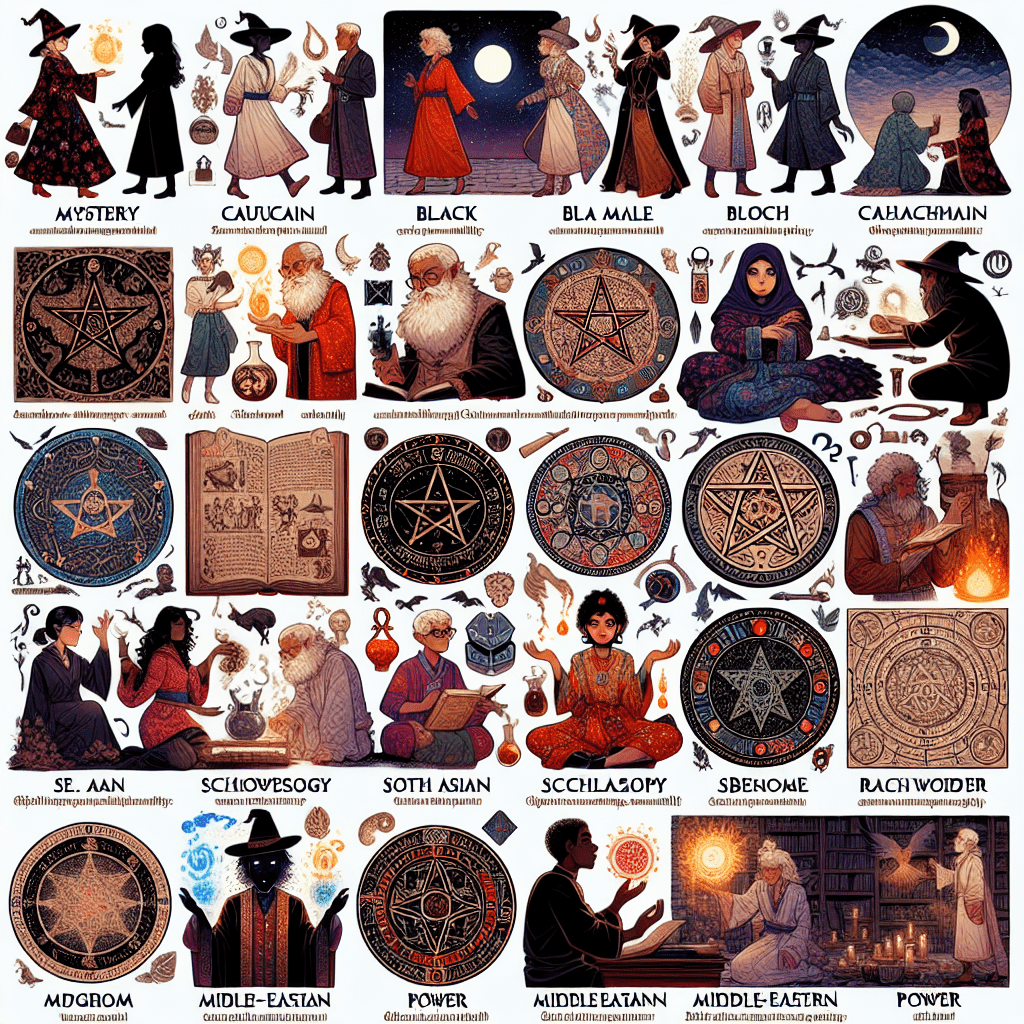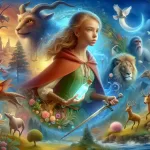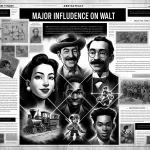-
Table of Contents
“Unlocking the Mystique: A Deep Dive into Witchcraft Symbols, Themes, and Characters.”
Witchcraft symbols play a significant role in the representation of magical practices and beliefs throughout history. These symbols often embody themes of power, transformation, and the connection between the natural and supernatural worlds. Common motifs include the pentagram, representing protection and the elements, and the cauldron, symbolizing transformation and the mysteries of life. Characters in witchcraft narratives often include witches, who embody both the feared and revered aspects of magic, as well as familiar spirits and deities that guide or challenge them. The exploration of these symbols and characters reveals deeper themes of societal norms, gender roles, and the struggle for autonomy in a world often hostile to the mystical and the unknown.
Overview of Witchcraft Symbols
Witchcraft symbols have long served as powerful representations of the beliefs, practices, and cultural significance associated with witchcraft throughout history. These symbols often encapsulate complex ideas and emotions, acting as conduits for spiritual energy and as tools for practitioners to connect with the metaphysical realm. Understanding these symbols requires a nuanced exploration of their origins, meanings, and the contexts in which they are employed.
One of the most recognizable symbols associated with witchcraft is the pentagram, a five-pointed star often enclosed within a circle. This symbol has been used for centuries, with its roots tracing back to ancient civilizations. In contemporary witchcraft, the pentagram is frequently interpreted as a representation of the five elements: earth, air, fire, water, and spirit. Each point of the star corresponds to one of these elements, emphasizing the interconnectedness of nature and the universe. The circle surrounding the star symbolizes unity and protection, creating a sacred space for practitioners. Thus, the pentagram serves not only as a protective emblem but also as a reminder of the balance and harmony that witches seek to achieve in their practices.
Another significant symbol is the triple moon, which consists of three phases of the moon: the waxing, full, and waning. This symbol is often associated with the goddess and the feminine divine, representing the three stages of a woman’s life: maiden, mother, and crone. The triple moon encapsulates the cyclical nature of life and the importance of embracing change and transformation. In many traditions, the moon is also linked to intuition and the subconscious, further enhancing its significance in witchcraft. By invoking the triple moon, practitioners honor the divine feminine and acknowledge the power of lunar energies in their rituals and spellwork.
Furthermore, the ankh, an ancient Egyptian symbol resembling a cross with a loop at the top, is often associated with life and immortality. In the context of witchcraft, the ankh can symbolize the connection between the physical and spiritual realms, serving as a reminder of the eternal nature of the soul. This symbol encourages practitioners to explore their spiritual journeys and to seek knowledge beyond the material world. The ankh’s rich history and multifaceted meanings make it a valuable symbol for those engaged in witchcraft, as it embodies the quest for understanding and enlightenment.
In addition to these symbols, various herbs, crystals, and animals also hold significant meanings within witchcraft. For instance, the use of herbs such as sage and rosemary is common in rituals for purification and protection. Similarly, crystals like amethyst and quartz are believed to possess unique energies that can enhance magical workings. Animals, too, play a vital role in witchcraft symbolism; for example, the owl is often associated with wisdom and intuition, while the black cat is frequently linked to protection and good fortune. Each of these elements contributes to the rich tapestry of witchcraft, allowing practitioners to draw upon a diverse array of symbols to enhance their spiritual practices.
In conclusion, witchcraft symbols are not merely decorative; they are imbued with deep meanings and serve as vital tools for practitioners. By understanding the significance of symbols such as the pentagram, triple moon, and ankh, as well as the roles of herbs, crystals, and animals, one can gain insight into the intricate beliefs and practices that define witchcraft. These symbols facilitate a connection to the spiritual world, guiding practitioners on their journeys of self-discovery and empowerment. As such, they remain essential components of the witchcraft tradition, reflecting the enduring human desire to understand and engage with the mysteries of existence.
Common Themes in Witchcraft Literature
Witchcraft literature has long captivated audiences with its rich tapestry of themes that explore the complexities of human experience, societal norms, and the supernatural. One of the most prevalent themes in this genre is the struggle for power and autonomy. Characters often find themselves at odds with societal expectations, leading to a quest for personal agency. This theme is particularly evident in works that depict witches as figures of rebellion against patriarchal structures. By embracing their identities and powers, these characters challenge the status quo, highlighting the tension between individual desires and societal constraints.
Another significant theme in witchcraft literature is the exploration of morality and ethics. The portrayal of witches often raises questions about good and evil, as well as the consequences of one’s actions. Characters may grapple with moral dilemmas, forcing readers to consider the complexities of right and wrong. This theme is frequently illustrated through the use of magical powers, which can be wielded for both benevolent and malevolent purposes. The duality of magic serves as a metaphor for the human condition, suggesting that the potential for both creation and destruction exists within everyone.
Furthermore, the theme of community and isolation plays a crucial role in witchcraft narratives. Witches are often depicted as outsiders, marginalized by society due to their beliefs and practices. This sense of isolation can lead to a profound exploration of the human need for connection and belonging. In many stories, witches form their own communities, creating bonds that challenge societal norms. These relationships often serve as a source of strength, illustrating the importance of solidarity in the face of adversity. Conversely, the theme of betrayal can also emerge, as characters navigate the complexities of trust and loyalty within their communities.
The relationship between nature and the supernatural is another common theme in witchcraft literature. Witches are frequently associated with the natural world, drawing power from the elements and the cycles of life. This connection to nature not only emphasizes the importance of environmental stewardship but also reflects a deeper understanding of the interconnectedness of all living things. The portrayal of witches as guardians of nature often serves as a critique of industrialization and the exploitation of the earth, urging readers to reconsider their relationship with the environment.
Additionally, the theme of transformation is central to many witchcraft narratives. Characters often undergo significant changes, whether through the acquisition of magical powers, personal growth, or the consequences of their actions. This theme of metamorphosis can symbolize the journey of self-discovery, as characters confront their fears and desires. The transformative power of magic serves as a catalyst for change, allowing characters to break free from societal constraints and embrace their true selves.
In conclusion, witchcraft literature is rich with themes that resonate deeply with the human experience. The struggle for power and autonomy, the exploration of morality, the dynamics of community and isolation, the relationship with nature, and the theme of transformation all contribute to the genre’s enduring appeal. Through these themes, readers are invited to reflect on their own lives and the societal structures that shape their experiences. As witchcraft literature continues to evolve, it remains a powerful medium for examining the complexities of identity, morality, and the human condition, ensuring its relevance in contemporary discourse.
Key Characters in Witchcraft Stories
In the realm of witchcraft stories, key characters often embody the complex interplay of power, morality, and societal norms. These narratives frequently feature witches, who serve as central figures, representing both the allure and the danger of the supernatural. Traditionally, witches are depicted as women who possess extraordinary abilities, often derived from a deep connection to nature or ancient knowledge. This portrayal reflects historical anxieties surrounding female empowerment and autonomy, as witches are frequently marginalized figures who challenge the status quo.
In many tales, the witch is not merely a villain but a multifaceted character whose motivations can be deeply sympathetic. For instance, characters like the misunderstood witch in “The Crucible” or the benevolent healer in “The Witches” illustrate the duality of witchcraft. These characters often grapple with societal rejection and personal loss, which adds layers to their narratives. As a result, they become symbols of resilience and defiance against oppressive forces, inviting readers to reconsider their preconceived notions about witchcraft and its practitioners.
Moreover, the presence of the witch hunter or antagonist is equally significant in these stories. Figures such as the infamous Judge Danforth in Arthur Miller’s “The Crucible” or the relentless witchfinder Matthew Hopkins during the English Civil War serve to highlight the moral complexities of witchcraft narratives. These characters often embody the fears and prejudices of their societies, acting as agents of persecution who seek to maintain control through fear and violence. Their motivations are frequently rooted in a desire for power, social order, or personal vendettas, which complicates the moral landscape of the story. This dynamic creates a tension that propels the narrative forward, as the conflict between the witch and the hunter often reflects broader societal struggles.
In addition to witches and their adversaries, other characters play crucial roles in shaping the themes of witchcraft stories. The innocent bystander, often a victim of circumstance, serves to illustrate the collateral damage of witch hunts. Characters like Elizabeth Proctor in “The Crucible” or the children in “The Witches” highlight the vulnerability of those caught in the crossfire of fear and hysteria. Their experiences evoke empathy and serve as a reminder of the human cost of societal paranoia. This aspect of the narrative underscores the theme of innocence lost, as characters are forced to confront the harsh realities of a world driven by suspicion and mistrust.
Furthermore, the inclusion of mentors or wise figures, such as the character of Granny Weatherwax in Terry Pratchett’s “Discworld” series, adds depth to the exploration of witchcraft. These characters often serve as guides, imparting wisdom and knowledge to younger witches or those seeking understanding. They embody the idea that witchcraft is not merely about power but also about responsibility and ethical considerations. Through their teachings, these characters challenge the notion of witchcraft as inherently malevolent, instead presenting it as a complex practice intertwined with morality and community.
In conclusion, the key characters in witchcraft stories are instrumental in conveying the intricate themes and moral dilemmas associated with witchcraft. Through their diverse portrayals, these characters invite readers to engage with the historical and cultural contexts of witchcraft, prompting a reevaluation of the narratives that have shaped societal perceptions of witches. As these stories unfold, they reveal the enduring relevance of witchcraft as a lens through which to examine power dynamics, gender roles, and the human condition.
The Significance of Symbols in Witchcraft
Witchcraft, a practice steeped in history and folklore, employs a rich tapestry of symbols that serve as conduits for meaning, intention, and connection to the spiritual realm. These symbols are not merely decorative; they embody the beliefs, rituals, and philosophies of practitioners, providing a visual language that transcends spoken words. Understanding the significance of these symbols is crucial for grasping the broader themes and narratives that permeate witchcraft.
At the heart of witchcraft symbolism lies the pentacle, a five-pointed star often enclosed within a circle. This symbol represents the five elements—earth, air, fire, water, and spirit—each contributing to the balance and harmony sought by practitioners. The pentacle serves as a reminder of the interconnectedness of all things, emphasizing the belief that every element plays a vital role in the universe. Consequently, the pentacle is not only a protective emblem but also a representation of the holistic nature of witchcraft, where the physical and spiritual realms intertwine.
Another significant symbol is the cauldron, which embodies transformation and the alchemical process. Traditionally associated with the feminine divine, the cauldron is a vessel for creation, healing, and divination. It signifies the womb of the Earth, where ingredients are combined to produce something new, reflecting the cyclical nature of life and death. In this context, the cauldron becomes a powerful symbol of potential and the mysteries of existence, inviting practitioners to explore their inner depths and the transformative power of their craft.
Furthermore, the use of herbs and plants in witchcraft is laden with symbolic meaning. Each herb carries its own unique properties and associations, often linked to specific intentions or outcomes. For instance, rosemary is commonly associated with remembrance and protection, while lavender symbolizes tranquility and purification. By incorporating these natural elements into rituals, practitioners not only harness their physical properties but also invoke the deeper meanings embedded within them. This practice underscores the theme of nature as a source of wisdom and power, reinforcing the belief that the natural world is alive with spiritual significance.
Moreover, symbols in witchcraft often serve as tools for empowerment and self-expression. The act of creating or using symbols allows practitioners to articulate their beliefs and intentions, fostering a sense of agency in their spiritual practices. For example, the use of sigils—symbols created for a specific purpose—demonstrates the personal nature of witchcraft. Each sigil is imbued with the practitioner’s energy and intention, transforming it into a powerful focal point for manifestation. This process highlights the theme of individual empowerment, as practitioners take an active role in shaping their realities through the symbols they create.
In addition to personal empowerment, symbols in witchcraft also foster a sense of community and shared identity among practitioners. Many symbols, such as the triple moon or the ankh, resonate across various traditions and cultures, creating a sense of belonging among those who identify with witchcraft. These shared symbols serve as touchstones for collective understanding and connection, reinforcing the idea that witchcraft is not merely an individual pursuit but a communal practice rooted in shared beliefs and experiences.
In conclusion, the significance of symbols in witchcraft extends far beyond their aesthetic appeal. They encapsulate the core themes of interconnectedness, transformation, empowerment, and community, serving as vital tools for practitioners to navigate their spiritual journeys. By engaging with these symbols, individuals can deepen their understanding of witchcraft and its rich tapestry of meanings, ultimately enhancing their connection to the craft and the world around them.
Analyzing Themes of Power and Control
In the realm of witchcraft, symbols serve as potent representations of deeper themes, particularly those of power and control. These themes are intricately woven into the fabric of witchcraft narratives, reflecting the complex dynamics between individuals and societal structures. The symbols associated with witchcraft, such as the pentagram, the cauldron, and the broomstick, are not merely decorative; they embody the struggle for autonomy and the assertion of influence over one’s environment.
The pentagram, often associated with protection and the elements, symbolizes the balance of power within the natural world. It represents the witch’s ability to harness elemental forces, thereby asserting control over both the physical and metaphysical realms. This control is not solely about domination; rather, it reflects a deeper understanding of the interconnectedness of all things. In this context, the pentagram becomes a symbol of empowerment, illustrating how knowledge and mastery of natural forces can lead to personal agency.
Similarly, the cauldron serves as a multifaceted symbol of transformation and creation. It is within the cauldron that ingredients are combined, representing the alchemical process of change. This transformation is emblematic of the witch’s ability to manipulate circumstances and outcomes, thereby exerting control over her destiny. The act of brewing potions or crafting spells signifies a reclamation of power, particularly in societies where women have historically been marginalized. Thus, the cauldron not only symbolizes the witch’s craft but also her defiance against oppressive structures that seek to limit her agency.
The broomstick, often depicted as a means of transportation, further illustrates the theme of power and control. Traditionally associated with flight, the broomstick symbolizes freedom and escape from societal constraints. It allows the witch to transcend the limitations imposed by her environment, embodying the desire for liberation. This theme resonates deeply in narratives where witches are portrayed as outcasts or rebels, challenging the status quo. The broomstick, therefore, becomes a vehicle for empowerment, enabling the witch to navigate both the physical and spiritual realms with autonomy.
Moreover, the themes of power and control in witchcraft are often juxtaposed with societal fears and prejudices. Throughout history, the witch has been a figure of both fascination and fear, embodying the anxieties of a society grappling with issues of gender, authority, and the unknown. The persecution of witches during various historical periods underscores the lengths to which societies will go to maintain control over those who challenge established norms. This tension between empowerment and oppression is a recurring motif in witchcraft narratives, highlighting the precarious balance between individual agency and societal constraints.
In analyzing these themes, it becomes evident that witchcraft symbols are not merely artifacts of folklore; they are rich with meaning and significance. They encapsulate the struggles for power and control that resonate across cultures and eras. The witch, as a symbol of defiance and autonomy, challenges the boundaries imposed by society, inviting a reevaluation of traditional power dynamics. Ultimately, the exploration of these themes within witchcraft narratives reveals a profound commentary on the human condition, reflecting our ongoing quest for agency in a world often marked by limitations and constraints. Through the lens of witchcraft, we gain insight into the complexities of power, control, and the enduring spirit of resistance that defines the human experience.
Character Archetypes in Witchcraft Narratives
Character archetypes in witchcraft narratives serve as essential components that enrich the storytelling experience, providing depth and resonance to the themes explored within these tales. These archetypes often embody universal traits and motivations, allowing readers to connect with the characters on a fundamental level. One of the most prominent archetypes is the witch herself, who is frequently portrayed as a powerful figure capable of wielding magic and influencing the world around her. This character often embodies duality; she can be both a benevolent healer and a malevolent sorceress, reflecting society’s complex relationship with femininity and power. The witch’s portrayal varies significantly across different cultures and time periods, yet she consistently challenges societal norms, making her a compelling figure in witchcraft narratives.
In contrast to the witch, the archetype of the innocent victim often emerges, typically represented by young women or children who become targets of persecution. This character highlights the themes of fear and misunderstanding that often accompany witchcraft narratives. The innocent victim serves as a catalyst for the witch’s actions, whether it be through seeking protection or inadvertently triggering the witch’s wrath. This dynamic not only emphasizes the vulnerability of certain individuals within society but also critiques the broader societal tendency to scapegoat those who are different or misunderstood. As the narrative unfolds, the innocent victim’s plight often elicits empathy from the audience, drawing attention to the injustices faced by marginalized groups.
Another significant archetype is the wise mentor, often depicted as an older figure who possesses extensive knowledge of magic and the natural world. This character frequently guides the protagonist, imparting wisdom and skills necessary for navigating the complexities of witchcraft. The wise mentor embodies the theme of knowledge as power, illustrating how understanding and mastery of one’s abilities can lead to empowerment. Furthermore, this archetype often serves as a bridge between the mundane and the magical, helping to demystify the practices associated with witchcraft. Through their guidance, the mentor not only aids the protagonist but also reinforces the idea that wisdom is a vital component of any magical journey.
Additionally, the archetype of the skeptic plays a crucial role in witchcraft narratives. This character often embodies rationality and skepticism, challenging the beliefs and practices associated with witchcraft. The skeptic’s presence introduces conflict, as they question the validity of magic and the motivations of those who practice it. This archetype serves to highlight the tension between belief and disbelief, ultimately prompting characters and readers alike to confront their own perceptions of reality. The skeptic’s journey often leads to a transformation, as they may come to accept the existence of magic or, conversely, reinforce their disbelief through the events that unfold.
Moreover, the archetype of the antagonist, often represented by a rival witch or a figure of authority, introduces further complexity to the narrative. This character typically embodies the societal fears surrounding witchcraft, acting as a foil to the protagonist. The antagonist’s motivations may stem from jealousy, a desire for power, or a commitment to upholding societal norms. Through their conflict with the protagonist, the antagonist not only drives the plot forward but also serves as a reflection of the societal tensions surrounding witchcraft, illustrating the struggle between conformity and individuality.
In conclusion, character archetypes in witchcraft narratives are instrumental in shaping the themes and messages conveyed within these stories. By embodying universal traits and motivations, these archetypes facilitate a deeper understanding of the complexities surrounding witchcraft, power, and societal dynamics. Through their interactions and conflicts, these characters invite readers to explore the multifaceted nature of human experience, ultimately enriching the narrative landscape of witchcraft literature.
The Evolution of Witchcraft Symbols in Modern Culture
The evolution of witchcraft symbols in modern culture reflects a complex interplay between historical traditions, societal perceptions, and contemporary reinterpretations. Historically, symbols associated with witchcraft were often steeped in superstition and fear, serving as markers of the unknown and the misunderstood. In medieval Europe, for instance, the pentagram was frequently linked to malevolent practices, representing a connection to the occult and the supernatural. This association was largely fueled by the witch hunts of the time, during which symbols were used to identify and vilify those accused of witchcraft. As a result, the pentagram became a potent emblem of fear, often depicted in literature and art as a sign of evil.
However, as society progressed into the Enlightenment and beyond, the perception of witchcraft symbols began to shift. The rise of rational thought and scientific inquiry led to a reevaluation of these symbols, moving them away from their sinister connotations. In the 19th and 20th centuries, the revival of interest in folklore and the occult gave rise to a more romanticized view of witchcraft. Symbols such as the crescent moon and the triple goddess emerged as representations of femininity, nature, and empowerment. This transformation marked a significant departure from the earlier associations of witchcraft with malevolence, instead embracing themes of healing, intuition, and connection to the earth.
In contemporary culture, the evolution of witchcraft symbols has continued to reflect broader societal changes. The rise of neopaganism and Wicca has played a crucial role in redefining these symbols, imbuing them with new meanings that resonate with modern spiritual practices. The pentacle, for example, has been reclaimed as a symbol of protection and balance, representing the five elements: earth, air, fire, water, and spirit. This reinterpretation highlights a shift towards a more positive understanding of witchcraft, emphasizing harmony with nature and the empowerment of individuals, particularly women.
Moreover, the influence of popular culture cannot be overlooked in this evolution. Television shows, films, and literature have contributed significantly to the public’s perception of witchcraft symbols. Series such as “Charmed” and “American Horror Story” have popularized various symbols, often blending traditional meanings with contemporary narratives. This fusion has led to a proliferation of witchcraft imagery in fashion, art, and social media, where symbols like the moon phases and herbal motifs are embraced as expressions of personal identity and spirituality. As a result, witchcraft symbols have become a form of cultural currency, allowing individuals to explore their own beliefs and connections to the mystical.
In addition to their aesthetic appeal, these symbols often serve as a means of community building among those who identify with witchcraft or related spiritual practices. Social media platforms have facilitated the sharing of knowledge and experiences, allowing individuals to connect over shared interests in witchcraft symbols and their meanings. This communal aspect has further contributed to the normalization of witchcraft in modern society, transforming it from a subject of fear into one of curiosity and exploration.
In conclusion, the evolution of witchcraft symbols in modern culture illustrates a remarkable journey from fear and superstition to empowerment and community. As these symbols continue to adapt and resonate with contemporary audiences, they reflect broader themes of identity, spirituality, and the ongoing quest for understanding the mysteries of the human experience. Through this lens, witchcraft symbols have transcended their historical roots, becoming powerful emblems of personal and collective expression in today’s world.
Q&A
1. **What are common symbols associated with witchcraft?**
Common symbols include the pentagram, the triple moon, the cauldron, and the broomstick.
2. **What themes are prevalent in witchcraft literature?**
Themes often include the struggle for power, the conflict between good and evil, the nature of femininity, and the quest for knowledge.
3. **Who are typical characters found in witchcraft stories?**
Typical characters include witches, familiars, magical creatures, and often a hero or heroine who opposes the witch.
4. **What does the pentagram symbolize in witchcraft?**
The pentagram symbolizes protection, the elements, and the connection between the physical and spiritual realms.
5. **How is the theme of persecution depicted in witchcraft narratives?**
The theme of persecution often highlights the historical witch hunts, showcasing the fear and misunderstanding surrounding witchcraft.
6. **What role do familiars play in witchcraft?**
Familiars are often depicted as animal companions that assist witches in their magical practices and serve as spiritual guides.
7. **How does witchcraft literature explore the concept of empowerment?**
Witchcraft literature frequently explores empowerment through the reclamation of feminine power, self-discovery, and the defiance of societal norms.Witchcraft symbols often represent various themes such as power, transformation, and the connection between the natural and supernatural worlds. Common symbols include the pentagram, cauldron, and broomstick, each carrying rich meanings related to protection, healing, and the practice of magic. Characters in witchcraft narratives frequently embody archetypes such as the wise woman, the outcast, or the seeker of knowledge, reflecting societal attitudes towards witchcraft and its practitioners. Overall, witchcraft serves as a lens through which themes of empowerment, fear, and the struggle for identity are explored, highlighting the complex interplay between belief systems and cultural narratives.







